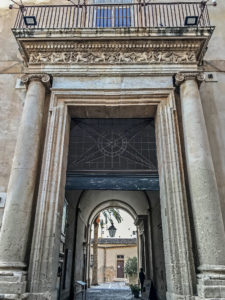Thanks to a recent restoration, Palazzo Nicolaci can be appreciated in all its original beauty and is one of the symbols of Sicilian Baroque art. It was the city’s noble residence of the Nicolaci family and has four storeys: the ground floor was used for stables and storing food; the first floor was the piano nobile (main floor) where the Baron lived; the rest of the family stayed on the upper floor, and the attic was for the servants.  The entrance portal is framed by two columns and is surmounted by a large balcony.
The entrance portal is framed by two columns and is surmounted by a large balcony.
The façade is a street theatre reminiscent of the theatre of Sicilian
puppets
because of the masks and characters carved into it.
Anyone passing through Via Corrado Nicolaci is in awe of the incredible
corbels
. Five for each balcony, they depict mythological figures including mermaids, sphinxes and horses. Each corbel is richly decorated, almost as though in fear of leaving even the smallest of spaces free.
Such attention to decoration can be found in the cornices around the windows; they feature plant elements, human faces and masks.
As for the material used, it is the typical stone of Noto which turns a honey colour when hit by the sun and emits endless colours depending on the time of day.